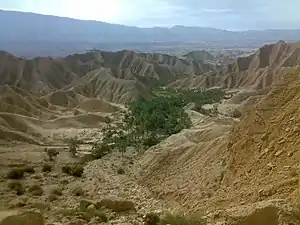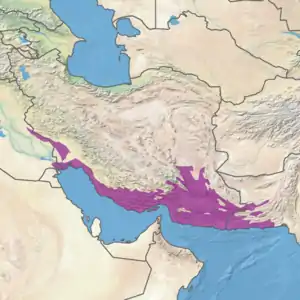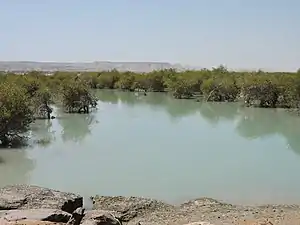South Iran Nubo-Sindian desert and semi-desert
The South Iran Nubo-Sindian desert and semi-desert ecoregion (WWF ID:PA1328) covers the northern coastal plain of the Persian Gulf and the inland desert hills south of the Zagros Mountains of Iran. The region also has extensions reaching into southeastern Iraq, and eastward into southwestern Pakistan. The region is one of hot sand deserts, shrubland, and open thorn woodlands inland. Mangrove forests and swamps are found along the coast.[1][2][3]
| South Iran Nubo-Sindian desert and semi-desert | |
|---|---|
 Landscape in Bushehr Province, Iran | |
 Ecoregion territory (in purple) | |
| Ecology | |
| Realm | Palearctic |
| Biome | Deserts and xeric shrublands |
| Geography | |
| Area | 352,234 km2 (135,998 sq mi) |
| Country | Iran, Iraq, Pakistan |
| Coordinates | 27.25°N 60.75°E |
Location and description
The ecoregion stretches for 1,600 kilometres (990 mi) along the northern coast of the Persian Gulf, from the head of the Gulf at Abadan to the estuary of the Hingol River on the southern coast of Pakistan 150 km west of Karachi. For most of its length, the region reaches 120 km inland, but widen considerably east of the Strait of Hormuz. As it enters Pakistan the ecoregion lies on the Makran Coastal Range of mountains. Elevations range from sea level to {[convert|3283|m|ft}, with a mean of 559 metres (1,834 ft).[3]
Climate
The climate of the ecoregion is Hot desert climate (Köppen climate classification (BWk)). This climate features stable air and high pressure aloft, producing a hot, arid desert. Hot-month temperatures typically average 29–35 °C (84–95 °F).[4][5]
Flora and fauna
At the north end of the Gulf is the Shadegan Ponds on the delta of the Karun River. This internationally important wetland features brackish sedge marshes dominated by Bulrush (Scirpus) in the better drained areas, and Tamarix on the mudflats.[6][7] Farther south along the coast is a representative mangrove community at the deltas of the Rud-e-Gaz and Rud-e-Hara Rivers at Hormuz. This area features tidal creeks, mudflats, and mangrove swamp. At the mouths of the rivers are extensive stands of Grey mangrove (Avicennia marina), known locally as the Hara tree.
Most of the region (up to 90%), however, is hot sandy desert with sparse vegetation. 8% is herbaceous cover or converted to agriculture.
The region is important for reptiles and amphibians. Common species are the Iranian toad (Bufotes surdus), The Baluch ground iguana (Trapelus persicus), the Iranian short-fingered gecko (Stenodactylus affinis), the Ocellated skink (Chalcides ocellatus), Rock semaphore gecko (Pristurus rupestris), and the False cobra (Rhagerhis moilensis).[3][8]
Endemic species of reptiles and amphibians include Blanford's short-toed gecko (Cyrtopodion brevipes), the Jaz murian bent-toed gecko (Mediodactylus sagittifer), the Iranian worm snake (Xerotyphlops wilsoni), and the Bungarus persicus, a venomous snake of the Elapidae family.[8]
Protected areas
Over 7% of the ecoregion is officially protected.[3] These protected areas include:
- Shadegan Ponds Wildlife Refuge (Iran).
- Geno Biosphere Reserve (Iran).
- Mangrove forests of Qeshm (Iran).
- Hingol National Park (Pakistan).
- Mond protected area (Iran).
References
- "South Iran Nubo-Sindian desert and semi-desert". World Wildlife Federation. Retrieved March 21, 2020.
- "Map of Ecoregions 2017". Resolve, using WWF data. Retrieved September 14, 2019.
- "South Iran Nubo-Sindian desert and semi-desert". Digital Observatory for Protected Areas. Retrieved August 1, 2020.
- Kottek, M., J. Grieser, C. Beck, B. Rudolf, and F. Rubel, 2006. "World Map of Koppen-Geiger Climate Classification Updated" (PDF). Gebrüder Borntraeger 2006. Retrieved September 14, 2019.CS1 maint: multiple names: authors list (link)
- "Dataset - Koppen climate classifications". World Bank. Retrieved September 14, 2019.
- "Shadegan Marshes & mudflats of Khor-al Amaya & Khor Musa". Ramsar Sites Information Service. Retrieved 25 April 2018.
- "Shadegan marshes and tidal mudflats of Khor-al Amaya and Khor Musa". Birdlife International. Retrieved October 18, 2020.
- "The Herpetofauna of Iran: Checklist of Taxonomy, Distribution and Conservation Status". Asian Herpetological Research (December 2015). doi:10.16373/j.cnki.ahr.140062. Retrieved October 17, 2020.
